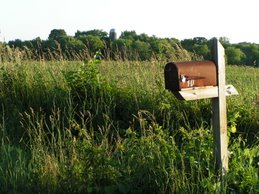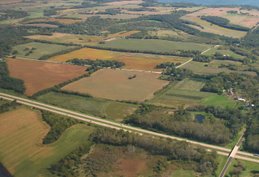Expanded version of Jan. 10, 2008 Letter to Editor, Fitchburg Star
Submitted by Phyllis Hasbrouck
Chair of the West Waubesa Preservation Coaliton
“Just Trust Us”
The main message that I heard from developer Phil Sveum and his team on Dec. 18 was “Just trust us.” They painted a picture of a “green development” in the Northeast Neighborhood, but with no real substance. They are “looking at” encouraging homebuyers to use efficient plumbing fixtures, limit lawn watering, create and maintain raingardens, and use rain barrels. They assure us that when they complete their CDP (comprehensive development plan) it will have measures adequate to protect Lake Waubesa, Swan Creek, the springs and the groundwater.
Should the Plan Commission just take their word for it? How many times have cities been left holding the bag when a stormwater plan went bad? Developers sure are good at sweet talking, but once they finish the project, they are done, and all problems are left to the city.
Can Neighborhood Associations be Depended on?
All of the neighborhood-wide water-saving and stormwater control features of the Sveum plan depend on a Neighborhood Association to carry them out, and that’s a real weakness. It’s hard to find people willing to put in the volunteer hours for the good of the whole neighborhood. Harlan Hills (which was built by Sveum to be an “environmental development”) has a neighborhood association, but it hasn’t stopped people from using the pesticides that Sveum said would be banned. People have mowed down prairie and incorporated pieces into their yards, and concerned residents were told that suing their neighbors is the only way they can get the covenants enforced.
It’s very easy to say, “the outlot raingardens, the repair and plowing of the alleys, and the greenways will all be managed by a dues-collecting neighborhood association,” but the reality may be quite different. A recent Capital Times article talked about the many area residents who buy homes without realizing that their street is private, and that they’ll have to pay for its upkeep. What if new residents of the NEN can’t or won’t keep up the raingardens, alleys and greenways? Will Phil Sveum step in and pay? Will the city? Or will the environment have to pay? I understand that Fitchburg has never allowed private streets. I hope that they stick to their principles when it comes to private allies, greenways, and infiltration features.
What makes anyone believe that the people who move into such a development will be interested in conserving tap water or maintaining raingardens? Congratulations to Commissioner McNally, who brought a sense of reality back to the discussion when he asked whether we could really count on all of these ambitious plans happening!
A Memorandum is not a Promise
The Ruekert-Mielke stormwater report was a list of goals, with no concrete suggestions to describe how the goals would be met. The Montgomery Associates Memorandum on water is a slight improvement. It describes the general sort of techniques that they plan to use, e.g. “providing multiple points of treatment and infiltration of runoff as close to the impervious surfaces as possible.” But we are told to wait until they have a comprehensive development plan to see exactly what kind, how many, and where such measures will be. Can it be that this is the accepted way of approving developments – to just take the say-so of people who have every reason to skimp once they have the approval?
Rob Montgomery, Sveum’s water expert, said “Those [municipal] wells draw water from the lower aquifer relatively isolated from the upper aquifer, and also draw from a wider region of Fitchburg and areas to the west.” People who attend or watch the next Plan Commission meeting at 7 p.m. in City Hall on Jan. 15 will learn that this is not so, when they hear Dr. Cal DeWitt speak on buried bedrock valleys.
The memorandum says that “Water draining off the Par Fore site will be managed to exceed state and local ordinance criteria for water quality, peak discharge rates, and runoff volumes.” Once again, we are told to just trust them. Everything will be done according to the law. But does that mean that it won’t harm the environment? The environment has been gravely harmed by development, and presumably most of that development was done within the law. We need some leadership by people willing to defend the resources that will sustain our grandchildren!
Groundwater, Lakes and Phosphorus
Rob Montgomery’s conclusion was that “placing consideration of the Northeast Neighborhood ‘on hold’ because of regional groundwater management concerns is not warranted. We suggest that an appropriate approach for the Planning Commission is to approve the neighborhood plan including an objective of maintaining groundwater recharge, and recommending appropriate municipal water supply conservation practices.” Translation: “Just write down that it would be good for people to save water and let rainwater infiltrate, and let us go about our business.”
It was encouraging to hear Commissioner Kinney ask Rob Montgomery how he could ensure that the water going in to Swan Creek would be both cleaner and of the same volume post-development. I hope that all the commissioners will be asking skeptical and probing questions, as they are responsible for the welfare of the entire community.
Some commissioners may think that the question of phosphorus has been laid to rest with City Engineer Paul Woodard’s calculations that post-development the NEN will contribute less phosphorus to surface waters than it presently does. While this may be true, (a schedule of corn, corn, and soy results in a lot of phosphorus runoff) it is not the relevant question to ask. Because Lake Waubesa is already partly eutrophic, a large reduction in phosphorus loading is needed, not a small one. Small scale, organic farming could be the best option of all for protecting and restoring Lake Waubesa, and it should be studied.
Workforce Housing and the Future of Fitchburg
Kudos to Alder Allen and Mayor Clauder for bringing up the issue of workforce housing. This is a huge need, but it won’t be met unless the city insists on it. Our proposal for the Northeast Neighborhood, which we will present to the Plan Commission in Feb., contains 30 units of workforce housing, for the farmers, teachers and entrepreneurs who will run the school of organic farming, the farmers market, and the Bike and Breakfast that we envision. The people who will be attracted to inhabit the NEN if our vision is realized will definitely be interested in and dedicated to saving water, infiltrating rainwater, stopping soil loss, rejecting pesticides, and creating a vibrant, closely knit community.
I hope that the Plan Commission and Common Council will remember that the choice before them is not between Mr. Sveum’s proposal and the worst possible development. The choice is between Mr. Sveum’s proposal, just leaving the land in agriculture, or endorsing our plan to preserve our lakes and groundwater while producing healthy food for the community.



No comments:
Post a Comment